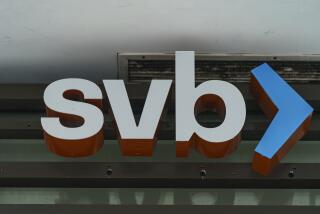Democrats Ponder Politics of Linking Bank, S&L; Crises
- Share via
WASHINGTON — Congressional Democrats, eager to link the banking and savings and loan crises politically, are debating whether to merge banking reform legislation moving through Congress with the Bush Administration’s demands for another $80 billion in S&L; cleanup funds.
With the Senate Banking Committee set to begin voting today on banking reform, some Democrats are searching for ways to gain political advantage from the twin crises afflicting the nation’s financial institutions, congressional sources said Tuesday.
Forcing the separate issues into one catchall bill, some Democrats believe, might associate the White House more closely with the rising cost of the savings and loan debacle. The Administration has told Congress that the agency handling the S&L; crisis needs another $80 billion this fall--on top of $80 billion it has already spent--to finish the clean-up.
The Democrats hope to connect the Administration’s push for deregulation in the banking industry with the need to clean up the thrift industry, which collapsed after it was deregulated in the early 1980s under the Ronald Reagan Administration.
In fact, some Democrats are charging that a bailout of the banking industry, similar to the thrift salvage operation, is under way. They note that the Bush banking plan will require Congress to give a $70-billion line of credit to the federal deposit insurance fund to help cover insured deposits at banks seized by the Federal Deposit Insurance Corp.
Joining the two issues would provide a platform for critics to undermine the Administration’s campaign for banking reform and would give the Democrats a chance to publicly attack the Republicans for their handling of the S&L; crisis.
“If they could link the banking crisis (with S&Ls;), then they could say, ‘Here we go again,’ ” said one congressional source.
Treasury Secretary Nicholas F. Brady strongly opposes any attempt to merge the S&L; and banking measures.
The legislative gambit might not occur, however, when the Senate Banking Committee casts its votes on the banking bill this week. Sources in the Senate said Democrats might wait until the legislation reaches the Senate floor before trying to tie the two measures together.
Even if banking reform is kept separate, the committee is likely to give the banking industry much less in the way of expanded business powers than the Administration would like.
Banking Committee Chairman Donald W. Riegle Jr. (D-Mich.) is pushing a much more restrictive approach to banking reform than the Administration initially proposed. His plan also is narrower than one approved by the House Banking Committee in June.
Riegle strongly opposes a key aspect of the Administration’s reform plan that would allow commercial and industrial firms to buy banks. In order to block that provision, Riegle has enlisted the support of the committee’s ranking Republican, Sen. Jake Garn (R.-Utah). In a compromise hammered out in the last few days, Garn has agreed to a proposal that would prohibit such mergers. In return, Riegle has agreed not to sponsor an amendment to tie S&L; financing to the banking reform measure.
Despite that agreement, the Administration is expected to lobby hard for the provisions to allow industrial and commercial firms to buy banks.
Further complicating the outlook, hundreds of amendments to the banking reform measure have been proposed at the last minute by Democrats and Republicans. Riegle and other key committee members have held closed-door negotiations for weeks in an attempt to forge a compromise bill that could be voted on quickly in a public session.
On the S&L; front, the board of the Resolution Trust Corp., the federal agency created to oversee the thrift clean-up, voted Tuesday to approve the hiring of another 1,421 employees to help seize and dismantle failed S&Ls.; The additional personnel will increase the agency’s work force to 9,559.
The board also voted to begin an aggressive program of hiring firms owned by women and minorities to participate in managing assets of failed S&Ls.; The Times recently disclosed that minority-owned firms had received only 6% of the $961 million in estimated fees for contracts awarded by the RTC.
More to Read
Get the L.A. Times Politics newsletter
Deeply reported insights into legislation, politics and policy from Sacramento, Washington and beyond. In your inbox three times per week.
You may occasionally receive promotional content from the Los Angeles Times.










